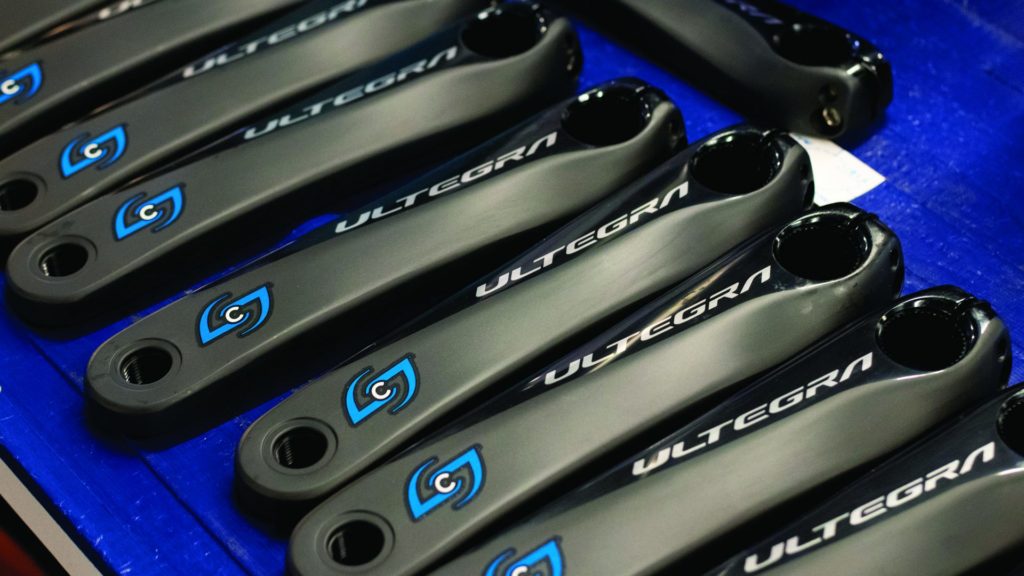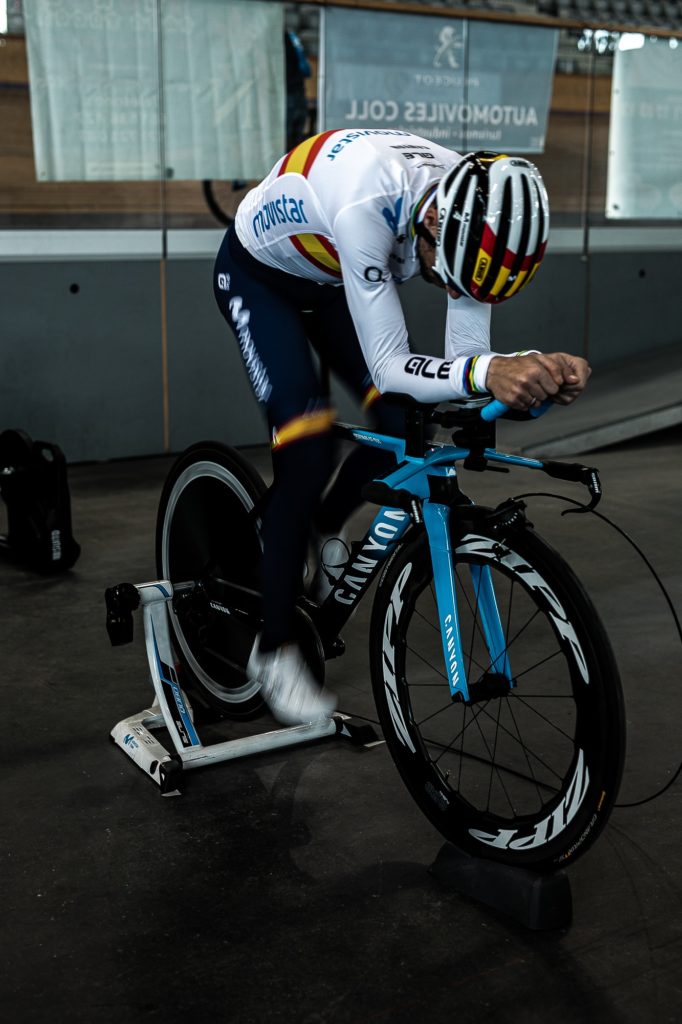Spring is in the air! The weather is turning, cyclists are riding outside more, and triathletes are ramping up for their early season races.
If you’re looking to get an edge in your training on the bike this season, buying a power meter is the single best investment you can make. But this doesn’t come without its own learning curve. Whether you are looking to interpret all the lingo that comes with your new power meter or just trying to decide if shelling out the cash is a good decision—you’ve come to the right place.
This is your crash course in power meters (no crashing necessary… I promise!).
Let’s start by answering the basic questions about power meters for triathletes: what, where, why and how.
What A Power Meter Is
The first basic concept we need to discuss is what a power meter actually is.
Simply put, this is a device that you put on your bike to measure the amount of power you are producing. To say that another way, this is an objective measure of effort. It answers the question “how hard am I really pushing the pedals?”
Most power meters today are called “Direct Force” power meters because they directly measure and record the amount of force you are putting into the drivetrain (everything from the pedals to the rear wheel). This measurement is calculated by strain gauges similar to a torque wrench.

The electronics in the power meter take this measure of torque, or the strain you are placing on it, and multiplies it by the speed at which you are pedaling (called cadence) and then displays a number on your GPS computer or smartwatch (referred to as a head unit). This number is the amount of watts that you are producing by pedaling and generally speaking, the higher the better.
Just like a lightbulb, toaster, or microwave, the average triathlete is a machine of sorts and improving watt score translates to more power on the bicycle.
Where Power Meters Are Placed
If a power meter is a device that is placed on your bike, the next question to answer is “where is it placed?”
Since a power meter measures strain in the drivetrain, then naturally it must be placed in the drivetrain somewhere. Where, though, depends on which model you have.
Starting in the pedals, you could have something like the Garmin Vector 3’s which simply replace your existing pedals. These are a good choice if you want to switch them from bike to bike often.
Next, is the crank arm like the units from Stages. Again these will replace the left arm of the crank. The downside here is that they only measure power on one side and double the number (to account for both feet pedaling). Early models weren’t always reliable but manufacturers have since addressed those issues and there are few remaining doubts on the accuracy of these units.

Then you have the crank or spider-like the units from Quarq. These can be purchased as a whole unit and replace the crank on your bike. 10+ years of development have helped refine installation, enhanced durability, and smoothed out capability issues with bottom brackets.
The final type is in the rear hub. While these used to be a very popular option, they are less so now as they usually had to be bought as part of the wheelset or be laced into an existing wheelset. That means if you have both training and racing wheels you had to buy 2 power meter hubs, or do without depending on the set of wheels you were using.
Why You Should Train With A Power Meter
So why even buy a power meter? Why would you want to know how many watts you were pushing into the pedals?
The first reason is that of objectivity! Without a power meter, you would have to rely on other measurements to train and race by.
- Speed?— Affected by too many variables (wind, gravity, etc)
- Heart Rate?— Can drift over time and can be affected by caffeine or hydration status
- RPE (rate of perceived exertion)?— Based on perception and can be affected by caffeine, adrenaline, mood, etc.
Not that any of these are bad. No! I’m of the opinion that you need to collect data on all these points and learn from them. But power is the only objective measure. 100 watts is the same no matter how you feel, what direction the wind is blowing, or how much caffeine you had.

With this objective measure, it is easier to perform a structured training plan (intervals, etc.). It is also possible to practice an even pace across long training rides (instead of starting too hard and fading over the ride).
These reasons only scratch the surface, but having a power meter opens up additional possibilities like measuring TSS (training stress) over the course of your training, or measuring the amount of work performed in a ride (KiloJoules) which translates to calories burned (helpful if weight loss or maintenance is an objective).
How To Get The Most Out Of A Power Meter
With all that information it comes down to “how.” You can’t just throw a power meter on your bike and expect to see improvement. That said, I recommend getting your power meter installed and spending a few weeks training as usual just to see how things line up.
From there, find a structured training plan or a coach who can guide you through your training. One of the first things a good plan or coach will have you do is perform an FTP test or similar. FTP is “Functional Threshold Power” and roughly is the power you could hold for an hour in a race scenario. I say “roughly” because it is really a range between 45-75 minutes. There is a lot more science behind what makes up FTP, but for our purposes, we’ll stick with the basic definition.
There are many different formats for an FTP test, but you can simply follow what your coach or training plan outlines for you. From there you can set your zones so that you will know how hard to push on hard days and how easy to go on easy days. This will also help when choosing your pacing plan before race day.
I’d be remiss to not at least briefly mention training software here as well. A power meter, when paired with an indoor or interactive trainer and popular software like TrainerRoad or Zwift, can be a game-changer in your training. These programs help the hours melt away on the indoor trainer and they provide structured plans to help you get faster in the process.
Finally, there is the development of your race pacing plan. Using a program like Best Bike Split you can create a super detailed plan ahead of race day and practice it in your training. You can fine-tune your plan by trial and error in training, especially when practicing brick workouts (running off the bike). This can prevent you from leaving some effort out on the course or worse, blowing up on race day.
When pacing a long ride or race, you can look at your Normalized Power (NP) to see just how much effort that time has taken. While an average of your watts may read lower due to time spend coasting, the Normalized Power may be high due to accelerations up hills or passing other riders. The difference between NP and Avg. Power is called Variability Index (VI). The closer the VI is to 1.00, the more steady the pace of the ride (a good thing for triathletes!).
So when it comes to training and racing, I hope you see the value of investing in a power meter. If you don’t have one yet, get one! If you have one already, learn as much as you can!
This guide to power meters for triathletes is a good place to get the ball (or bike?) rolling for beginners and veterans alike. But the more you know, the more you can take advantage of the equipment and fitness you have. If you want to learn more, I recommend you read Training And Racing With A Power Meter by Hunter Allen and Andrew Coggan, which will take you deeper into this subject of power meter use (and even has a full chapter on triathlon racing!).
Ready to take the plunge? Shop TriSports for a wide selection of power meters for road, mountain, gravel, cross and tri bikes at a wide selection of prices from top brands including Garmin, Stages, Quarq and more!
Author Nathan Deck is a husband, father, triathlete, and a teacher at heart. When he’s not training, he loves to mentor junior athletes new to the sport. Read more of his work at Triathlonpal and follow him on Twitter.
